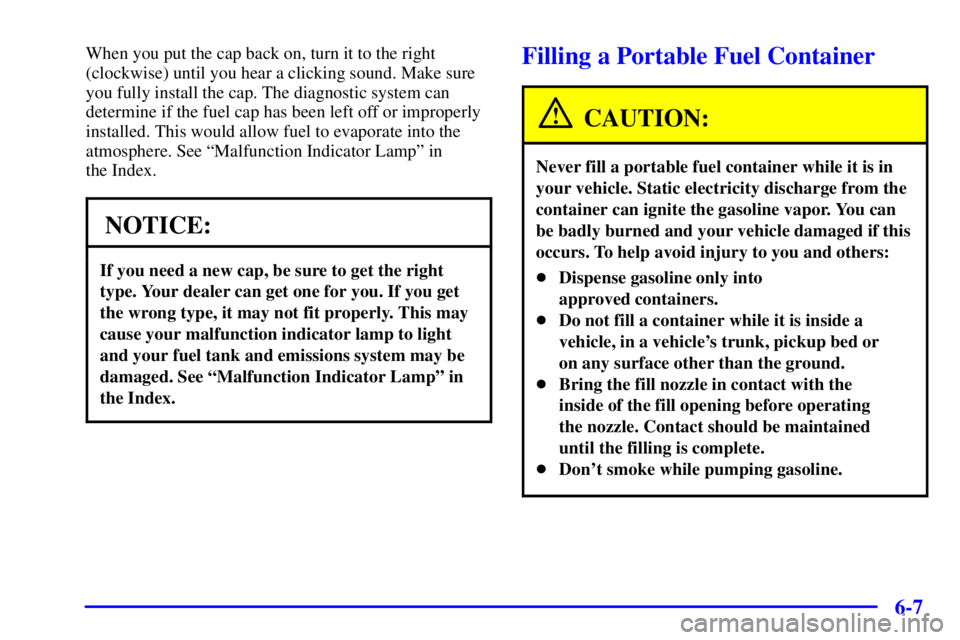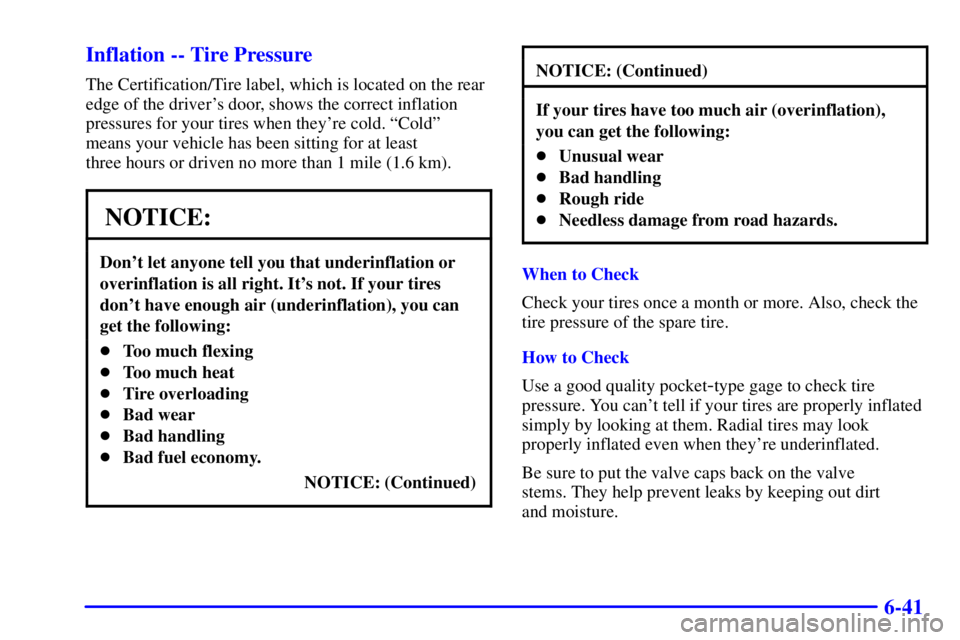Page 292 of 394

6-4
Be sure the posted octane is at least 87. If the octane is
less than 87, you may get a heavy knocking noise when
you drive. If it's bad enough, it can damage your engine.
If you're using fuel rated at 87 octane or higher and
you hear heavy knocking, your engine needs service.
But don't worry if you hear a little pinging noise when
you're accelerating or driving up a hill. That's normal,
and you don't have to buy a higher octane fuel to get rid
of pinging. It's the heavy, constant knock that means
you have a problem.
If your vehicle is certified to meet California Emission
Standards (indicated on the underhood emission control
label), it is designed to operate on fuels that meet
California specifications. If such fuels are not available
in states adopting California emissions standards, your
vehicle will operate satisfactorily on fuels meeting
federal specifications, but emission control system
performance may be affected. The malfunction indicator
lamp on your instrument panel may turn on and/or your
vehicle may fail a smog
-check test. See ªMalfunction
Indicator Lampº in the Index. If this occurs, return to
your authorized GMC dealer for diagnosis to determine
the cause of failure. In the event it is determined that the
cause of the condition is the type of fuels used, repairs
may not be covered by your warranty.Some gasolines that are not reformulated for low
emissions may contain an octane
-enhancing additive
called methylcyclopentadienyl manganese tricarbonyl
(MMT); ask your service station operator whether or
not the fuel contains MMT. General Motors does not
recommend the use of such gasolines. If fuels containing
MMT are used, spark plug life may be reduced and your
emission control system performance may be affected.
The malfunction indicator lamp on your instrument
panel may turn on. If this occurs, return to your
authorized GMC dealer for service.
To provide cleaner air, all gasolines in the United States
are now required to contain additives that will help
prevent deposits from forming in your engine and fuel
system, allowing your emission control system to
function properly. Therefore, you should not have to add
anything to the fuel. In addition, gasolines containing
oxygenates, such as ethers and ethanol, and
reformulated gasolines may be available in your area to
contribute to clean air. General Motors recommends that
you use these gasolines, particularly if they comply with
the specifications described earlier.
Page 295 of 394

6-7
When you put the cap back on, turn it to the right
(clockwise) until you hear a clicking sound. Make sure
you fully install the cap. The diagnostic system can
determine if the fuel cap has been left off or improperly
installed. This would allow fuel to evaporate into the
atmosphere. See ªMalfunction Indicator Lampº in
the Index.
NOTICE:
If you need a new cap, be sure to get the right
type. Your dealer can get one for you. If you get
the wrong type, it may not fit properly. This may
cause your malfunction indicator lamp to light
and your fuel tank and emissions system may be
damaged. See ªMalfunction Indicator Lampº in
the Index.
Filling a Portable Fuel Container
CAUTION:
Never fill a portable fuel container while it is in
your vehicle. Static electricity discharge from the
container can ignite the gasoline vapor. You can
be badly burned and your vehicle damaged if this
occurs. To help avoid injury to you and others:
�Dispense gasoline only into
approved containers.
�Do not fill a container while it is inside a
vehicle, in a vehicle's trunk, pickup bed or
on any surface other than the ground.
�Bring the fill nozzle in contact with the
inside of the fill opening before operating
the nozzle. Contact should be maintained
until the filling is complete.
�Don't smoke while pumping gasoline.
Page 329 of 394

6-41 Inflation -- Tire Pressure
The Certification/Tire label, which is located on the rear
edge of the driver's door, shows the correct inflation
pressures for your tires when they're cold. ªColdº
means your vehicle has been sitting for at least
three hours or driven no more than 1 mile (1.6 km).
NOTICE:
Don't let anyone tell you that underinflation or
overinflation is all right. It's not. If your tires
don't have enough air (underinflation), you can
get the following:
�Too much flexing
�Too much heat
�Tire overloading
�Bad wear
�Bad handling
�Bad fuel economy.
NOTICE: (Continued)
NOTICE: (Continued)
If your tires have too much air (overinflation),
you can get the following:
�Unusual wear
�Bad handling
�Rough ride
�Needless damage from road hazards.
When to Check
Check your tires once a month or more. Also, check the
tire pressure of the spare tire.
How to Check
Use a good quality pocket
-type gage to check tire
pressure. You can't tell if your tires are properly inflated
simply by looking at them. Radial tires may look
properly inflated even when they're underinflated.
Be sure to put the valve caps back on the valve
stems. They help prevent leaks by keeping out dirt
and moisture.
Page 355 of 394

6-67 Capacities
*Cooling System 14.8 quarts (14.0 L). . . . . . . . . . . .
*Cooling System with
Engine Oil Cooler 15.4 quarts (14.6 L). . . . . . . . .
Crankcase with Filter 6.0 quarts (5.7 L). . . . . . . . . . .
Fuel Tank
Denali 26.0 U.S. gallons (98.4 L). . . . . . . . . . . . . .
Denali XL 32.5 U.S. gallons (123.0 L). . . . . . . . . .
*Add 1.05 quarts (1 L) if equipped with rear heating.
All capacities are approximate. After refill, the levels
must be rechecked.
Normal Maintenance
Replacement Parts
Replacement part numbers listed in this section are
based on the latest information available at the time of
printing, and are subject to change. If a part listed in this
manual is not the same as the part used in your vehicle
when it was built, or if you have any questions, please
contact your GM dealer.These specifications are for information only. If you
have any questions, see the service manual for the
chassis or refer to the body manufacturer's publications.
Oil Filter* PF59. . . . . . . . . . . . . . . . . . . . . . . . . . . . . .
Engine Air Cleaner/Filter* A1518C. . . . . . . . . . . . . . .
Passenger Compartment
Air Filter Kit** 52485513. . . . . . . . . . . . . . . . . . . .
PCV Valve* CV948C. . . . . . . . . . . . . . . . . . . . . . . . .
Spark Plugs PTZ16R15 Denso***. . . . . . . . . . . . . . .
PZTR5A15 NGK***
Fuel Filter* GF626. . . . . . . . . . . . . . . . . . . . . . . . . . . .
Wiper Blades (Front)** 15706394. . . . . . . . . . . . . . .
Wiper Blade Type (Front) ITTA. . . . . . . . . . . . . . . . .
Wiper Blade Length (Front) 22.0 inches (56.0 cm). . .
Wiper Blades (Rear)** 22154396. . . . . . . . . . . . . . . .
Wiper Blade Type (Rear) ITTA. . . . . . . . . . . . . . . . . .
Wiper Blade Length (Rear) 18.0 inches (45.0 cm). . .
* ACDelco
� Part No.
**GM Part No.
***Spark Plug Gap is 0.060 inches